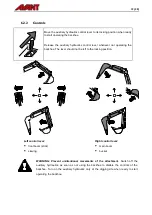
21 (28)
.
The bucket should not be pressed too hard downwards, since this would result in lifting
the outriggers lifting off the ground (and the front tyres of the loader), pulling the machine
towards the trench and making digging ineffective.
2
Operate the stick to pull bucket
parallel to the ground towards the
loader. At the same time, turn the
bucket to keep the flat bottom of the
bucket parallel to the ground.
On sloped terrains never pull
material from the sides to keep the
machine stable.
Preferably always drive the
loader
so
that
digging
is
performed from the front of the
loader.
3
With a sufficiently full bucket, close
the bucket and lift the backhoe
boom.
Dump material to the side, at least
60 cm from the excavation. Unstable
soils require more distance.
Repeat until it is necessary to move
the loader to another position.
Operate the backhoe only with its own hydraulic system and set of controls. Do not
excavate by using the driving force of the loader. Working this way can damage the
loader boom or the backhoe.
Avoid sideways loading of the bucket. Working with the swivel force can damage the
backhoe or the loader boom. Do not allow the bucket to penetrate into the ground while
turning the backhoe sideways.
Avoid working with the dropping force by lowering the bucket quickly against the ground.
Also, do not use the bucket's falling force as a hammer or pile-driver. Working this way
can greatly reduce the machine's service life and damage the loader as well.




































